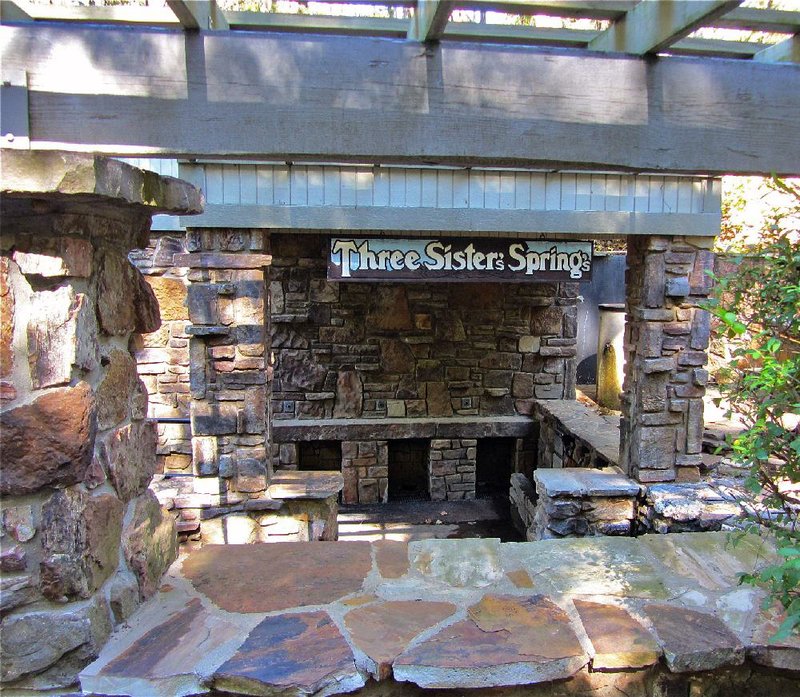LAKE OUACHITA STATE PARK - Decades before the creation of Lake Ouachita in the 1950s, another kind of water made a big splash in wooded Garland County to the northwest of Hot Springs.
Known as Three Sisters Springs, this underground source infused with minerals was sold locally and around the nation as a purported cure for a host of ailments. It’s now a notable history-related site in Lake Ouachita State Park, one of Arkansas’ most popular venues for swimming, boating, fishing, water skiing, scuba diving, camping and other outdoor diversions.
Located 15 miles or so from downtown Hot Springs, Three Sisters sits near the shoreline a bit east of the state park’s visitor center and busy marina. Water still bubbles up in the native-stone pavilion that shelters the springs, although a sign warns that “the water is not drinkable and is classified as nonpotable.”
That was far from the case in the late 19th century, when the Hot Springs area became a nationally known health resort. As reported in detail on state-park signs, Three Sisters was first claimed to contain healing properties by homesteader John McFadden in 1875. For the next three decades, under several owners, the springs remained open pools of water around which visitors pitched their tents.
After W.M. Cecil bought the site in 1907, he built McFadden’s Three Sisters Springs Resort, which eventually included tourist cabins and a bottling plant. Although later analysis showed that all three springs contain the same minerals in slightly different proportions, Cecil claimed that each one served as a remedy for different sets of diseases.
Spring No. 3, for example, was to be used “only for flux, diarrhea, dysentery, cholera-infantum and kindred troubles, bath for diabetic sores and eczema, granulated and sore eyes, catarrh of the head, nose and sinuses, etc.”
In an advertisement for the 1927-28 season, Cecil offered a deal: “To show and convince the public that these waters are in a class alone, I will make a special price of 10 cents per gallon at springs, and waters will be shipped to any part of United States on Tuesdays at the following prices. … Five-gallon bottles, crated by express, at $2.75. …30-gallon new oak paraffin barrels, by freight of express, at $8.50.”
The Great Depression evidently crippled Cecil’s business, and he sold the springs in 1939. The site was bought by the U.S. Army Corps of Engineers in 1951 as Blakely Mountain Dam was being built to create the largest lake entirely within Arkansas boundaries. Its 40,000 acres of fresh water are dotted with 212 islands and stocked with bream, crappie, catfish, striped bass and largemouth bass.
For lake explorers, the state park’s 70-slip marina rents a variety of craft: party barges, ski and fishing boats, pedal boats, canoes and kayaks. Something out of the ordinary is the Ouachita Geofloat Trail, a self-guided boating route focused on geology.
Landlubbers can hike the 4-mile Caddo Bend Trail along the shore of Point 50peninsula to the west of the visitor center. An overlook near the tip of the peninsula affords choice sunset views across the lake. The most interesting geological features along the trail, also near the tip, include folded layers of Paleozoic sandstone and shale, shoreline caves and quartz outcroppings.
Gorgeous autumn colors are a seasonal attraction in the forest around Lake Ouachita. State park rangers conduct fall foliage lake tours from the marina, with the first two scheduled for 2 p.m. on Oct. 26 and Oct. 28. The barge tours last about 90 minutes and cost $9 for adults, $5 for youngsters 6 to 12, free for tykes under 6.
For more information on Lake Ouachita State Park, call (501) 767-9366 or visit ArkansasStateParks.com. For overnight stays, the park has 103 campsites along with eight family cabins.
Weekend, Pages 35 on 10/17/2013
